Can the BJP can win in 2019? Exit Polls and Surveys only tell half the story, Here is what the BJP needs to do to win in 2019.
- In Politics
- 12:23 PM, May 26, 2018
- Mohal Joshi
In the run-up to the 2019 Lok Sabha elections I will be looking at the 2019 general elections from different statistical perspectives. Last month in my 2 part series (Part1 & Part2) I had looked at vote share and seats for 2014 and had also made projections for 2019. This time around I will take a detailed look at raw vote counts, voting patterns across income levels & young adult demographics.
Overall Picture:
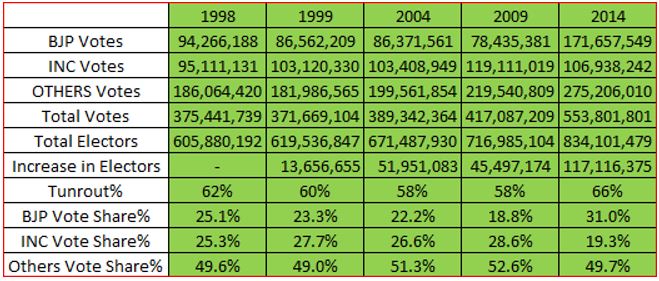
Looking at the past 5 elections (1998, 1999, 2004, 2009 & 2014), the total eligible electors (i.e. citizens above age of 18 eligible to vote) has risen dramatically from 605M (M = million) in 1998 to 834M in 2014.
Note: I shall refer to million as M in the article henceforth. (For reference 1 million = 10 lakh)
With the coming to the fore of India’s demographic dividend & the stupendous efforts of the Election Commission 117M+ people were added to the electoral rolls just before the 2014 election. I will touch upon the demographic dividend a bit later on.
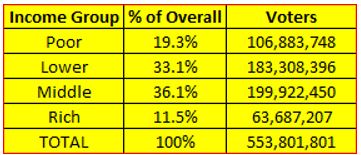
As per the LokNiti - CSDS [Centre for the Study of Developing Societies] post-poll survey for the 2014 election the voters who cast their votes were divided into 4 brackets: Poor, Lower Middle Class, Middle Class & Rich. These voters had respective weightage of 19.3%, 33.1%, 36.1% & 11.5% as percentage of the overall votes. Note: I have listed the approximate number of voters for each bracket based on total no. of voters who cast their ballots in 2014 extrapolated to these percentages from CSDS. CSDS data interestingly shows that majority of the votes (~69.2% of the votes) came from two classes: Lower Middle Class & Middle Class
Vote Share for BJP & INC across Income Classes:
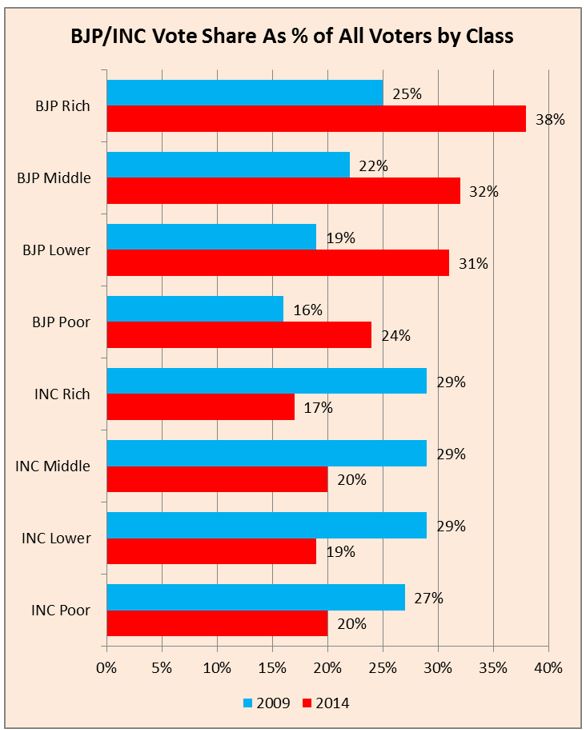
Looking at how each economic class voted across all party lines we can see that BJP won the huge victory in 2014 by increasing their vote share % across each & every class/income group. INC in comparison suffered a decline in vote share % across all classes/income groups.
Middle Class Disgruntlement:
Today looking ahead to 2019 there is certainly dissatisfaction among the electorate especially the middle class. While the poor & lower middle class have benefitted from a whole host of welfare schemes by Narendra Modi such as Ujjwala, Jan Dhan, MUDRA, DBT, Jan Aushadi, Suraksha Bima, Jeevan Bima, rural electrification, Swachh Baharat etc. the middle class felt left out. Today one can find a many articles in the media & anecdotes in the public discourse of this middle class discontent with BJP. This has been caused by various factors like rise of petrol prices, big tax breaks being not given, economic anxiety related to two major shocks in the system due to demonetization & GST, etc.
Many of the pre poll promises by BJP of Uniform Civil Code, scrapping of Article 370, Ram Mandir which is dear to a section of the middle class BJP voters also remain unfulfilled. BJP has to guard against losing the narrative before the 2019 elections. One has to remember that it took less than 2 years for the Congress to go from winning 200+ seats in mid-2009 to losing it during the UPA-2 rule due a whole host of scams & the Anna Hazare movement. The only silver lining for the BJP today is that in absence of massive anger & lack of trust in the opposition many of these voters look like sitting out & not switching over to the opposition. Every voter who switches over to voting for opposition candidate vs not voting would inflict double the damage as a crossover voter, this is something which I had gone into detail in my article last month.
Let’s assume that the surge in middle class voters from 22% in 2009 to 32% in 2014 is completely wiped out in 2019 due to this middle class dissatisfaction with the BJP led government. That is similar to 2009 only 22% of middle class voters vote for BJP in 2019. For sake of discussion I will consider these voters to either shift to INC, other parties or choose the NOTA option (vs abstaining from voting).
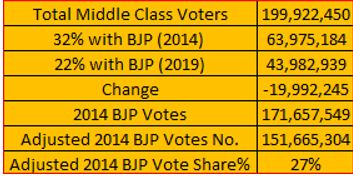
Looking at the numbers from 2014 just under 64M (32%) middle class voters voted for BJP which would drop to less than 44M (22%). This would lead to a net loss of approximately 20M voters a 12% relative loss in overall BJP votes from ~171M to ~151M. The new numbers would drop the BJP vote share % from 31 down to 27%. This could prove problematic for BJP as all seats won by 12% or less margin vs the runner up would be under threat & push the down overall BJP seat tally.
Young Adult Demographic Dividend:
So the question for BJP is how to replace this shortfall of 20M voters? The answer could lie in India’s demographic dividend. A vast number of youth are reaching adulthood & thus gaining the capability to vote for the first time. In the last general election a record 117M voters were added to the electoral rolls. In 2019 a further 132.7M (who will be between the ages of 18 to 22 in 2019 & were not able to vote 5 years ago as they were too young) will now be eligible to vote for the first time ever. This corresponds to a 16% increase in the number of total electors vs 2014 i.e. 1 out of every 6 voters.
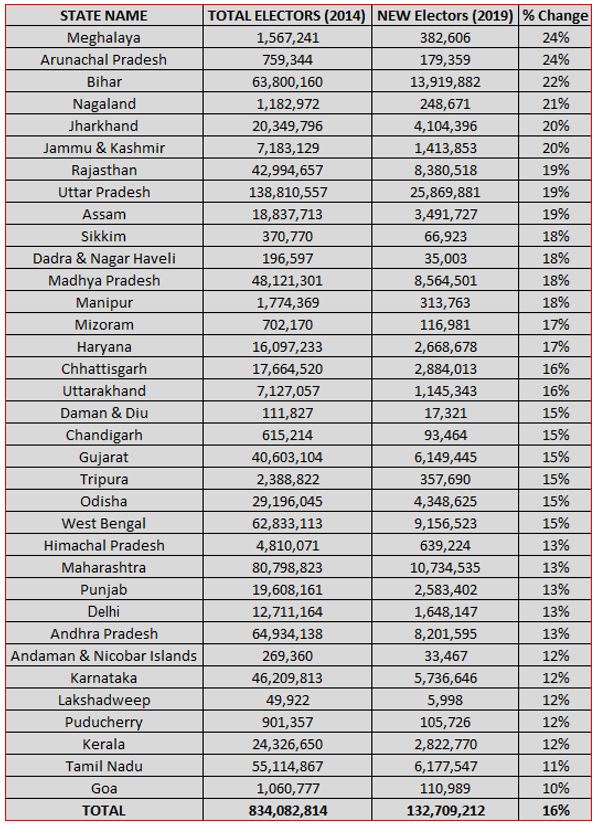
Looking closely at the numbers state wise in descending order of % increase in electors it is not at all surprising to see some of the northern states on the top where TFR (Total Fertility Rate) didn’t drop until recently while the southern states where TFR dropped in the past the increase is on the lower end of the scale. A larger than average portion of these new 18-22 year old voters reside in northern & central India where BJP is strong (for e.g. In Bihar & Jharkhand ~20% of all voters will be first time voters). Before the 2014 elections the Election Commission of India (ECI) did a very commendable job of increasing the electoral rolls by 117.1M new voters (vs the estimated population growth of 120.5M). Based on this I forecast that around 129M new voters should be added to the electoral rolls come 2019. This would then increase the total number of eligible voters/electors to ~963M (< 4% shy of 1 BILLION). To put this into perspective this number of is almost equal to combined populations of the world’s 3rd, 4th, 5th & 6th most populous countries in the world: USA, Indonesia, Brazil & Pakistan.
2019 Turnout %:
Next comes the question of turnout% for 2019 Lok Sabha Elections
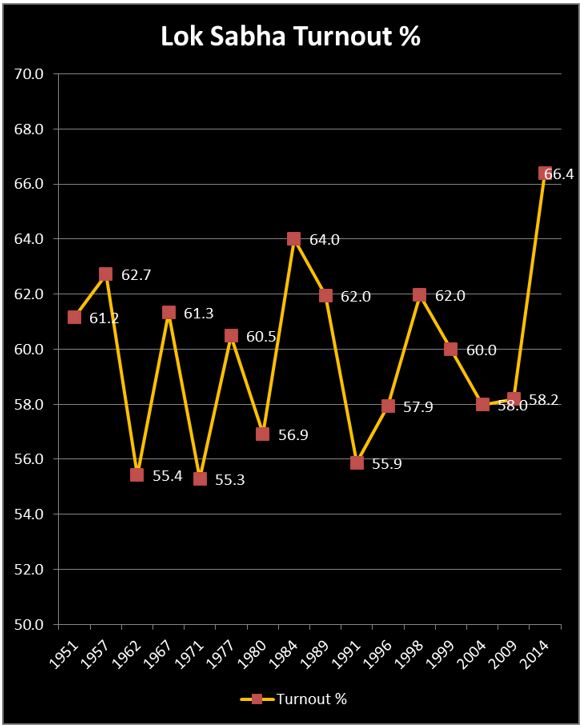
Historically Lok Sabha election turnout has been usually between 55 to 62% with 2 exceptions: 1984 when PM Indira Gandhi was assassinated & 2014 during the Modi wave.
Based on the recent history it could very well go back to historical mean of 60%. To ensure I consider various scenarios in terms of turnout I shall consider the following 4 possibilities.
- 60% (Recent historical mean)
- 66% (2014 Turnout %)
- 63% (avg. of possibility 1 & 2 above)
- 70% (An upsurge in voting turnout% due to infusion of new voters)
As per Sanjay Kumar (Director CSDS) the youth turnout% after being 4-5% lower than the overall turnout in previous elections cycles, in 2014 it was around 2% higher than the overall turnout. With increasing awareness & literacy rate the youth turnout % in 2019 shouldn’t fall back down precipitously. For the sake of simplicity in calculations here I am considering the 18-22 year old turnout to be the same as overall turnout%.
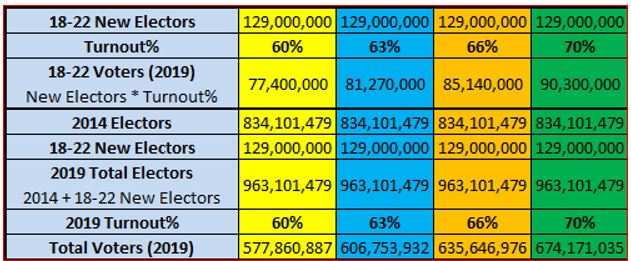
The number of 18-22 year old voters & the number of overall voters who cast their ballots in 2019 should vary between 77 - 90M & 577 - 674M respectively (depending on the turnout %).
BJP Vote Share% Compensation:
Now for BJP as mentioned earlier there is an expected loss of ~20M voters which brings down the no. of voters from ~171M to an adjusted new number of ~151M. Some level of opposition unity is to be expected in 2019. This means that it would be necessary for the BJP to win at a minimum 31% vote share that it got in 2014. This requires Modi to woo over the 18-22 year old first time voter to make up for the shortfall from the defections of 2014 voter base.
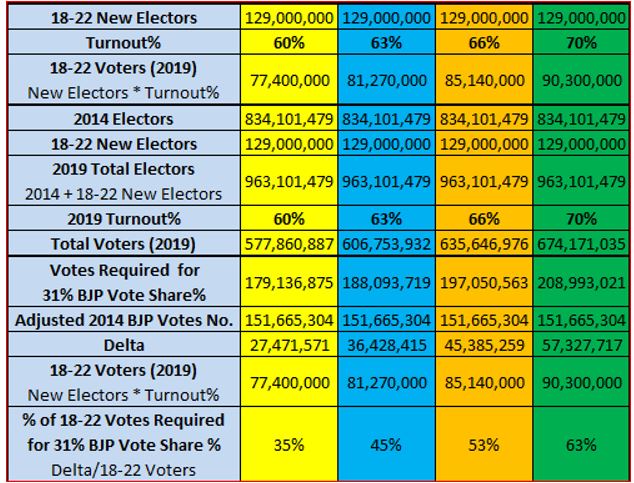
BJP would require somewhere between 179M to 208M total votes (which varies with the turnout %) to maintain the 31% overall vote share. To make up for the 20M defecting voters shortfall plus the growth in the voter base it requires (see “Delta” row in table above) anywhere between 27 to 57M new votes. This would mean that a significant of the 18-22 year old voters have to vote for BJP. BJP would have to win anywhere between 35 to 63% of 18-22 year old votes to maintain it’s 31% vote share.
Conclusion:
The good news is that recent surveys have confirmed the popularity of Narendra Modi with the youth. Modi should be able to win 1/3 of the first time voter votes but as the turnout increase it starts to become a steeper climb where he would have to win a very high 2/3 of new voter ballots. The opposition recently has been working hard on projecting chaos & misrule of the current government. The youth will not be swayed simply by these protests, disruptions & rallies as it doesn’t cater to their aspirations. They need instead need to be courted by an alternative vision for the country which seems to be lacking of the opposition as of today.
One should note that there are a still a lot of variables in play such as a possible move away from BJP from rich class which could make BJP task even harder or a move towards BJP in the poor category which would lessen the damage to BJP. The middle class which was at 36% of the voter base in 2014 (vs only 20% in 2009) could increase to even a larger percentage of the population with growth in prosperity. This could potentially make the number of voters defecting from BJP in 2019 even higher than the projected 20M.
What I have attempted to do here is highlight the impact of the loss of middle class voters on BJP vote share & the underappreciation of this huge upcoming demographic dividend. There is not a lot of discussion around this huge chunk of voters who are up for grabs in 2019. All political parties that ignore this demographic do so at their own peril as after all the 18-22 first timer voter constitutes 1 in every 6 voters in 2019!
Note: I want to thank both Amitabh Tiwari & Subhash Chandra for the exchanging information & thoughts for this article.



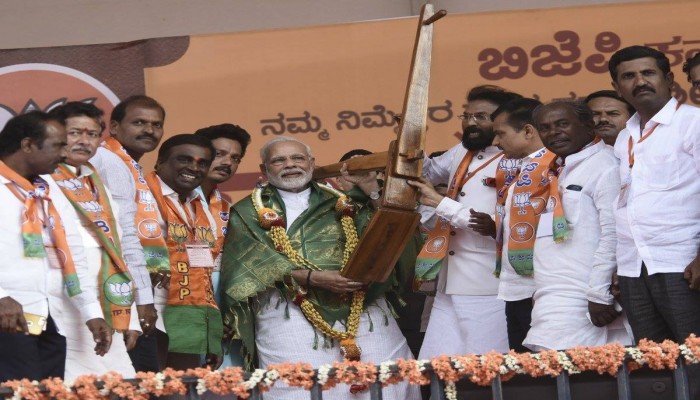
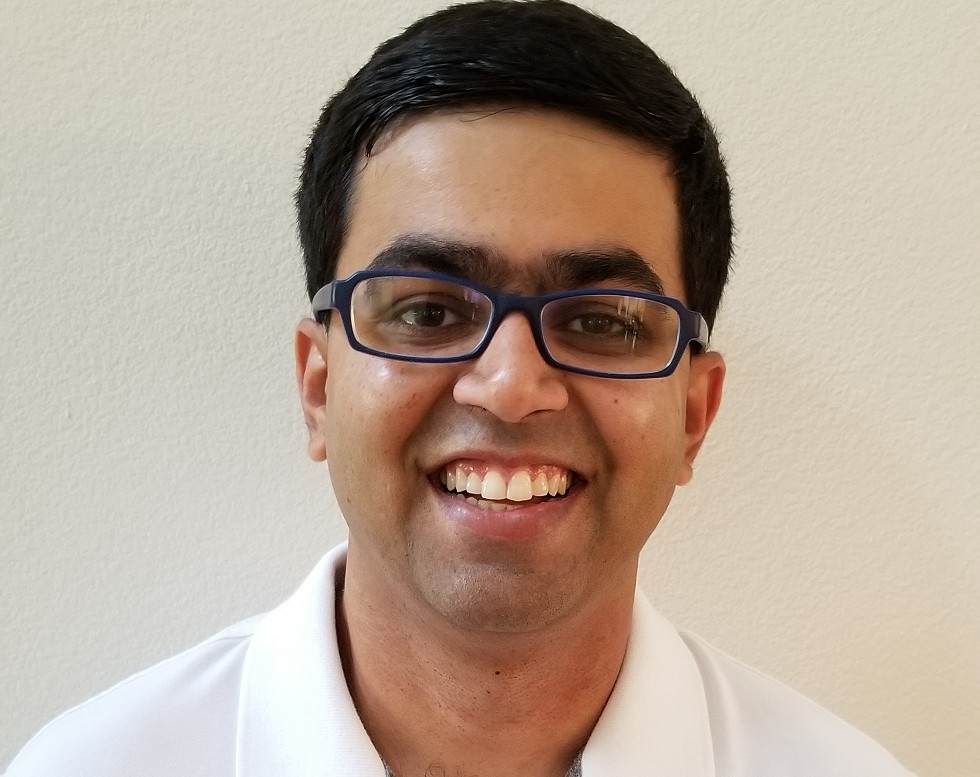


Comments